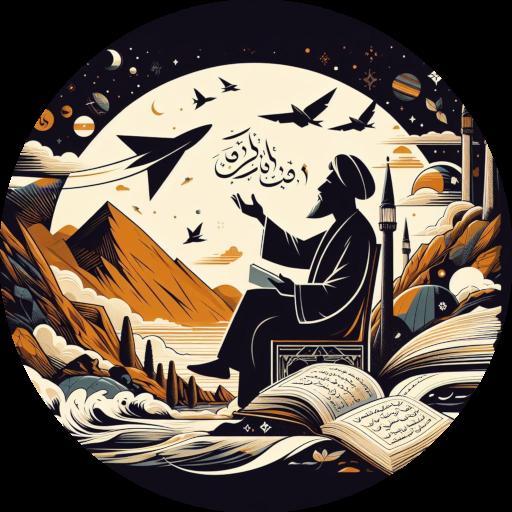Few poets of the Persian world blend subtle reasoning and passionate mysticism as elegantly as Saeb Tabrizi. A master of the Indian style (سبک هندی), he often turns abstract ideas into shimmering, tangible images.
This ghazal, brief yet layered, is a dialogue between the mind and the heart, between composure and madness, between the one who observes and the one who burns.
1. چند بتوان خاک زد در چشم، عقل و هوش را؟ / یا رب انصافی بده آن خطِ بازیگوش را
How long can I keep throwing dust into the eyes of reason and sense?
O Lord, grant me justice against that playful line of hair!
The opening line begins with protest, not against cruelty, but against beauty itself. The “line of hair” (khaṭṭ-e bāzīgūsh) refers to the faint, delicate hair above the beloved’s lip, a feature that drives lovers and poets alike to madness.
Saeb’s speaker can no longer fool his reason by pretending indifference. The mind, symbol of restraint, tries to keep its eyes clear, but love’s dust blinds it.
The verse carries Saeb’s typical wit of balance: reason and beauty are placed in opposition, but with humor and affection. Love is a game in which even the most disciplined mind must lose, and the poet asks heaven not for victory, but for fairness, as if saying: “If beauty will play, let love not always lose.”
2. کارِ من با سروبالایی است کز بس سرکشی / میشمارد حلقهٔ بیرونِ در، آغوش را
My affair is with a tall cypress-like beauty,
so proud that she counts even the ring of the door as my embrace.
The “cypress-like beauty” (sarv-bālā) is one of Persian poetry’s oldest metaphors, a symbol of grace, height, and aloofness. But Saeb transforms it with wit: the beloved is so proud, so distant, that even when the lover knocks on the door, she thinks the sound of the door-ring is his attempt to embrace her!
This image shows both the cruelty and charm of love. Pride (sar-keshi) is part of beauty’s majesty, it is what makes the beloved divine. To love such a being is to accept humiliation as worship.
Saeb’s tone is not bitter but admiring. In Persian mysticism, this proud beloved also represents the Divine, that eternal Presence who allows approach only to test the lover’s sincerity.
The poet, standing outside the door, discovers that longing itself is a kind of embrace.
3. از جهانِ بیخودی پایِ تزلزل کوته است / نیست پروای قیامت عاشقِ مدهوش را
In the world of selflessness, the foot does not tremble,
the intoxicated lover has no fear of the Day of Judgment.
Here, Saeb shifts from the human to the spiritual. The “world of selflessness” (jahān-e bīkhodī) is the realm of ecstasy, where the self dissolves in love. In that state, all anxiety and moral trembling vanish.
The lover who is truly “mad-intoxicated” (‘āshiq-e madhūsh) no longer fears heaven or hell, his only concern is the presence of the Beloved.
This line, though brief, expresses one of Saeb’s most profound mystical insights: that love itself is the judgment. The lover has already been tried and consumed in the fire of longing.
Why fear the afterlife, when one has already lost the self in the beloved’s glance?
4. زیرِ گردونِ سبکجولان چه عاجز ماندهای؟ / میتوان برداشتن از جوشی این سرپوش را
Why remain helpless beneath this swiftly-turning sky?
With a surge of passion, you can lift this cover away!
In a world where fate (gardūn) turns lightly and relentlessly, Saeb urges action, not despair. The “cover” (sarpūsh) may symbolize the limits of thought, the veil of habit, or even the weight of the material world.
What can remove it? Not logic, not philosophy, but josh, the boiling passion that rises from within.
Here, Saeb echoes the Sufi belief that spiritual awakening requires inner heat, not external control. Ecstasy (josh) is not chaos; it is a divine fire that burns away illusion.
His message: Stop lamenting beneath fate’s spinning sky. Passion itself is the power that frees you from its motion. The lover’s heart, when it boils, becomes stronger than destiny.
5. روزگاری شد ز جوشِ گفتگو افتادهام / کیست صائب تا به حرف آرد منِ خاموش را؟
It has been long since I fell silent, weary of the turmoil of words.
Who is there, Saeb, who can bring this silent one to speech again?
The final verse turns inward. After all the wit, irony, and imagery, Saeb ends in exhaustion. Words themselves, his tools and treasures, have lost their power.
The josh-e goftogu (fervor of discourse) has cooled. The poet has tasted too many arguments, too many clever phrases, and now seeks the stillness beneath them.
Yet there is also yearning in his silence: “Who will awaken my voice again?” he asks, as though waiting for the Beloved’s whisper. For Saeb, true speech does not come from intellect but from inspiration, from the spark of love that rekindles the tongue.
In the quiet that follows the storm of reason, he rediscovers the beginning of song.
The Dialogue of Fire and Dust
This ghazal, though brief, contains the essence of Saeb’s genius: every image is both literal and metaphysical. The playful line of hair is both a sign of the beloved’s body and the shadow of divine attraction. The cypress-like figure is both a proud woman and the unapproachable majesty of God.
Saeb does not reject reason, he exposes its limits. The poem moves from the dust that blinds intellect to the silence that transcends it.
At the heart of this journey lies a paradox:
Love begins with noise, with knocking on the door, with words and sighs, but ends in silence. Between the first cry and the final hush, the lover passes through humiliation, madness, and ecstasy.
The Logic of Madness
Saeb’s first question, “How long can I throw dust in reason’s eyes?”, is not only rhetorical but existential. It points to the human condition: we are beings of intellect who fall in love against our own wisdom.
To love is to lose the comfort of logic. Yet Saeb’s poetry shows that madness itself has its own order, a divine logic where losing becomes finding.
Every verse in this ghazal charts the failure of control: the lover cannot control reason, cannot reach the beloved, cannot fear judgment, cannot stay silent.
And yet, through these very failures, he reaches a higher harmony, a clarity born of surrender.
The Proud Beloved
The second verse offers one of the finest portraits of pride in Persian poetry. The beloved’s arrogance is not cruelty but necessity.
Love, to be love, must involve distance. The beloved’s hauteur sustains desire, turning every rejection into a form of invitation.
The lover’s knock on the door, mistaken for an embrace, becomes a metaphor for the entire human quest: we reach toward God, but our reaching is already our union.
This verse, in its humor, also reveals Saeb’s psychological insight. He sees pride not only in the beloved but in the lover’s longing itself, that secret hope that his pain is special, that his suffering has meaning.
The World of Selflessness
In the third verse, Saeb enters the heart of mystical experience. Bi-khodi, selflessness, is both an emotional state and a spiritual reality.
To lose oneself in love is to step outside the trembling of time. There, the lover no longer fears the world’s end, because he has already tasted eternity in a glance.
This verse connects Saeb to the great tradition of Persian mysticism, from Attar to Rumi to Hafez, yet his tone remains distinct. He does not soar into abstract rapture; he keeps one foot in human feeling. His mystic is also a realist, a man who knows what love costs, yet still chooses to burn.
The Boiling Point
The fourth verse is a call to awaken. The “lightly turning sky”, gardun-e sabok-jolān, represents the capriciousness of fate, the endless change that defines mortal life.
Saeb’s response is not despair but intensity: if the heavens move swiftly, the heart must burn faster.
This philosophy of inner fire defines much of Saeb’s later poetry. He believed that passion (josh) was both the test and the cure, the force that could lift the “cover” (sarpūsh) of limitation and reveal what lies beneath.
This is the poet’s rebellion: not against God, but against passivity. Even under a spinning sky, one can rise, through love’s heat.
The Silence of the Poet
And then comes the final note, quiet, personal, haunting.
After years of eloquence, Saeb admits that words themselves can become noise. The poet who has mastered wit and metaphor finds himself mute.
This is not defeat but evolution: he has reached the silence beyond expression, the still point where language bends toward prayer.
His question, “Who will bring me to speech again?”, is both humble and mystical. Only inspiration, only love, can awaken poetry anew. The poet no longer writes from craft but from grace.
Saeb’s Signature: The Wit of Balance
In every line of this ghazal, Saeb balances opposites:
-
Reason and passion (the mind versus the playful line of hair)
-
Speech and silence (eloquence versus the quiet of surrender)
-
Pride and humility (the beloved’s majesty versus the lover’s devotion)
-
Action and stillness (the call to lift the cover versus the final exhaustion)
This balance defines Saeb’s Sabk-e Hindi, the “Indian Style”, known for its compact metaphors, surprising logic, and inner tension.
Unlike earlier poets who sought musical flow, Saeb favors complexity, the moment when thought and feeling collide.
His ghazals are not streams of emotion but intricate reflections, where every image opens a new window on meaning. In this poem, the “dust,” the “door-ring,” the “sky,” and the “silence” all serve as mirrors, showing how the external world reflects the inner one.
The Human and the Divine
Though steeped in mystical imagery, Saeb’s poem never loses its human tenderness. The beloved may be divine, but the pain is earthly. The poet still knocks at a door, still sighs, still falls silent.
This blend of human vulnerability and cosmic insight is what makes Saeb so enduring. He speaks for both the mystic and the lover, the thinker and the fool.
Each verse contains both complaint and surrender, the lover’s rebellion and his reverence. He cannot stop throwing dust in reason’s eyes, because love itself is the dust that blinds and sanctifies.
The Poet’s Rest
In the end, Saeb sits in silence, not because he has nothing to say, but because he has said everything.
Words, once his companions, have become his veil. Beyond metaphor lies truth, and truth cannot be spoken.
His silence is not emptiness but fullness, a silence overflowing with meaning.
The ghazal ends not in resolution but in a quiet mystery: the poet’s final humility before the boundless game of love.
“Who will bring me to speech again?”
Perhaps, dear reader, it is we, centuries later, who answer him.
Every time we read Saeb, every time his metaphors stir our hearts, we bring the silent poet back to life.
His dust blinds our reason once more, and his playful line of thought, that khaṭṭ-e bāzīgūsh, teases us into love again.





